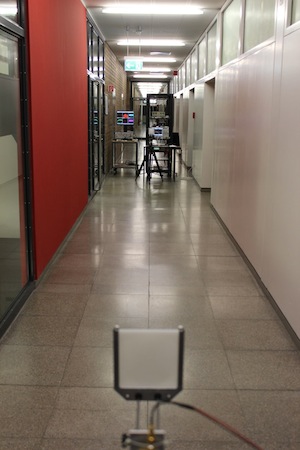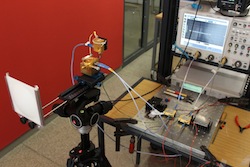Researchers at the Karlsruhe Institute of Technology (KIT) in Germany have succeeded in breaking the world record for wireless data transmission using a new method that has achieved a speed of 100 Gigabits per second.
The researchers were trying to prove that broadband data could be transmitted over radio relay links to cross rivers, motorways or nature protection areas – places that traditionally have been difficult to provide network coverage using macro or femtocell infrastructure.
KIT held the record-breaking experiment in their laboratory and succeeded in transmitting 100 gigabits of data per second over the 237.5 GHz frequency band over a distance of 20 metres, using a photonic method to generate the radio signals at the transmitter.
“Our project focused on integration of a broadband radio relay link into fibre optical systems,” explained Professor Ingmar Kallfass.
“For rural areas in particular, this technology represents an inexpensive and flexible alternative to optical fibre networks, whose extension can often not be justified from an economic point of view [and] at a data rate of 100 gigabits per second, it would be possible to transmit the contents of a blue-ray disk or of five DVDs between two devices by radio within two seconds only.”
According to the researchers, photonic and electronic technologies were combined. The radio signals were generated using an optical method, while several bits were combined using “data symbols” and transmitted at the same time.
After the radio transmission, fully integrated electronic circuits were used in the receiver.
The researchers had previously succeeded in transmitting data rates of 40 Gbps over a distance of more than one kilometre using a purely electronic system in May in another study known as the Millilink project, but using phonic technology takes away the need for an intermediate electronic circuit.

“It is a major advantage of the photonic method that data streams from fibre optical systems can directly be converted into high-frequency radio signals,” explained Professor Jürg Leuthold, who proposed the photonic extension.
“This advantage makes the integration of radio relay links of high bit-rates into optical fibre networks easier and more flexible. Due to the large bandwidth and the good linearity of the photon mixer, the method is excellently suited for transmission of advanced modulation formats with multiple amplitude and phase states. This will be a necessity in future fibre optical systems.”
KIT isn’t content to stop at 100Gbps, however, and believes that integrated miniaturised antennas could be used for indoor coverage to improve WLAN and WPAN networks.
“By employing optical and electrical multiplexing techniques, [for example] by simultaneously transmitting multiple data streams, and by using multiple transmitting and receiving antennas, the data rate could be multiplied,” said Swen König, KIT Institute of Photonics and Quantum Electronics (IPQ), who conceived and conducted the recent world-record experiment.
“Hence, radio systems having a data rate of 1 terabit per second appear to be feasible.”
Have you voted for your European Operator CTO of the Year? Click here to vote.


